Linz
| Linz | |
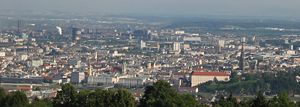 |
|
| Coat of arms | Location |
 |
 |
| Administration | |
| Country | |
|---|---|
| State | Upper Austria |
| District | Statutory city |
| Mayor | Franz Dobusch (SPÖ) |
| Basic statistics | |
| Area | 96.048 km² (37.1 sq mi) |
| Elevation | 266 m (873 ft) |
| Population | 188,968 (31/12/2005) |
| - Density | 1,967 /km² (5,096 /sq mi) |
| Other information | |
| Time zone | CET/CEST (UTC+1/+2) |
| Licence plate | L |
| Postal codes | 4010, 402x, 4030, 404x |
| Area code | 0732 |
| Website | www.linz.at |
Linz is the third largest city of Austria and capital of the state of Upper Austria (German: Oberösterreich). It is located in the north centre of Austria, approximately 30 km south of the Czech border, on both sides of the river Danube. The population of the city itself is 189,343 (2007), and 271,000 in the Greater Linz conurbation.
Contents |
History
The city was founded by the Romans, who called it "Lentia"[1], but there was already a Celtic settlement called "Lentos", and was first noted in 799 AD.[2] It was a provincial and local government city of the Holy Roman Empire, and an important trading point connecting several routes, on either side of the river Danube from the East to the West and Bohemia and Poland from north to the Balkans and Italy to the south. Being the city where the Habsburg Emperor Friedrich III spent his last years, it was, for a short period of time, the most important city in the empire.[3] It lost its status to Vienna and Prague after the death of the Emperor in 1493.

One important inhabitant of the city was Johannes Kepler, who spent several years of his life in the city studying mathematics. He discovered, on May 15, 1618, the distance-cubed-over-time-squared — or 'third' — law of planetary motion. Kepler is the namesake of the local public university. Another famous citizen was Anton Bruckner, who spent the years between 1855 and 1868 working as a local composer and church organist in the city. The local concert hall "Brucknerhaus" and a local private music and arts university are named after him.
Adolf Hitler was born in the border town of Braunau am Inn but moved to Linz in his childhood, spending most of his youth there. Hitler's parents are buried in the town of Leonding, near Linz. Hitler was enrolled in the Realschule [school], as was the philosopher Ludwig Wittgenstein. Hitler had extensive architectural plans for Linz, and wanted it to be the main cultural centre of the Third Reich. In order to make the city economically vibrant, Hitler initiated a major industrialization of Linz shortly before, and during, World War II. Many factories were dismantled in the newly-acquired Czechoslovakia, and then reassembled in Linz. One in particular came to be know as the Hermann-Göring-Werke, and still exists today as the voestalpine steel company. Linz grew to become a major industrial area; manufacturing chemicals and steel for the Nazi war machine. The Mauthausen-Gusen, located near Linz, were the last Nazi concentration camps to be liberated by the Allies. While in operation, they were the source of quarrying for stone for Hitler's prestige projects across the Reich. The main camp in Mauthausen is just 15.6 miles (25km) away from Linz.
After the war, the river Danube that runs through Linz — from the eastern side to the northern side — which separates the Urfahr district in the north from the rest of Linz — served as the border between the Russian and American occupation troops. The Nibelungen bridge that spans the Danube river from the Hauptplatz (main square) was at that time Linz's version of Checkpoint Charlie. The Nibelungen Brücke with the two bridge head buildings is the only architectural plan Hitler ever carried out in Linz.
Population development
| Year | Population |
|---|---|
| 1900 | 83,356 |
| 1951 | 184,685 |
| 1961 | 195,978 |
| 1971 | 204,889 |
| 1981 | 199,910 |
| 1991 | 203,044 |
| 2001 | 183,504 |
| 2006 | 188,968 |
The agglomeration includes (parts of) 13 other municipalities with together 271,000 inhabitants. Linz is also part of the Linz-Wels-Steyr metropolitan area of Upper Austria, home to around one third of the state's population (460,000 people) and second-largest urban area in Austria.[4][5]
Districts
Linz is divided into 9 districts and 36 statistical quarters. They are:
- Innenstadt: Altstadtviertel, Rathausviertel, Kaplanhofviertel, Neustadtviertel, Volksgartenviertel, Römerberg-Margarethen
- Waldegg: Freinberg, Froschberg, Keferfeld, Bindermichl, Spallerhof, Wankmüllerhofviertel, Andreas-Hofer-Platz-Viertel
- Lustenau: Makartviertel, Franckviertel, Hafenviertel
- St. Peter
- Kleinmünchen: Kleinmünchen, Neue Welt, Scharlinz, Bergern, Neue Heimat, Wegscheid, Schörgenhub
- Ebelsberg
- Urfahr: Alt-Urfahr, Heilham, Hartmayrsiedlung, Harbachsiedlung, Karlhofsiedlung, Auberg
- Pöstlingberg:Pöstlingberg, Bachl-Gründberg
- St. Magdalena: St. Magdalena, Katzbach, Elmberg
Economy
Linz is an industrial city. The Voestalpine AG is a large steel concern (founded as the "Hermann Göring Werke" during World War II), and which is known for the LD- ("Linz-Donawitz") procedure for the production of steel, and the former "Chemie Linz" chemical group, which has been split up into several companies. This has made Linz one of Austria's most important economic centres. Linz is also the home of PEZ — makers of peppermint candy.
Traffic
Linz also serves as an important transportation hub for the region of both Upper Austria and, to a lesser degree, southern Bohemia. The "Blue Danube" Linz Airport lies about 6.25 miles (10km) southwest of the town centre. Direct flights include Frankfurt, Düsseldorf and Vienna with additional seasonal routes added during the summer and winter months. Ryanair flies to London Stansted Airport.
The city lies on Austria's main rail axis, the so-called "Westbahn", linking Vienna with western Austria, Germany and Switzerland. There are also varying types of river transport on the Danube; from industrial barges to tourist cruise ships.
Main sights


The main street "Landstraße" leads from the "Blumauerplatz" to the main square. In the middle of this square the high "Pestsäule" ("plague column", also known as "Dreifaltigkeitssäule" (Dreifaltigkeit means Holy Trinity)) was built to remember the people who died in the plague epidemics.[6][7]
Near the castle, which is located on the same site as the old Roman fortress Lentia was once built — and also being the former seat of Friedrich the III — the oldest Austrian church is located: Sankt/Saint Martins church. It was built during early medieval Carolingian times.[8]
Other sights include:
- St. Mary's Cathedral (Mariendom), Roman Catholic.[9], in Gothic-Revival style
- Pöstlingberg-Kirche: is situated at the hill Pöstlingberg
- Brucknerhaus — the concert hall named after the composer Anton Bruckner, who was born in Ansfelden, a small town next to Linz.[10]
- Gugl Stadium, is home to the LASK (Linzer Athletik Sport Klub), which is claimed to be the third oldest soccer club in Austria.[11]
- The Linzer Landestheater[12] is the theater Adolf Hitler and his friend August Kubizek always went to, to hear Wagner.[13]
Culture

The city is now home to a vibrant music and arts scene that is well-funded by the city and the state of Upper Austria. Between the Lentos Art Museum and the "Brucknerhaus", is the "Donaulände", which is also referred to as "Kulturmeile" ("culture mile"). This is a park alongside the river, which is used mainly by young people to relax and meet in summer. It is also used for the Ars Electronica Festival and the "Linz Fest".[14] Linz has other culture institutions, such as the Posthof, which is near the harbour,[15] and the Stadtwerkstatt, which is by the Danube river.[16] Linz will become the European Capital of Culture in 2009.[17]
Art
The recently built Lentos (2003) is a modern art gallery, presenting art from the 20th and 21st centuries. It is situated on the south banks of the river Danube. The building can be illuminated at night from the inside with blue, pink, red, and violet, due to its glass casing.
The Ars Electronica Center (AEC) is a museum and research facility on the north bank of the Danube (in the Urfahr district), across the river from the Hauptplatz (main square). The AEC is a significant world center for new media arts, attracting a large gathering of technologically-oriented artists every year for the Ars Electronica festival. The AEC museum is home to one of the few public 3D CAVEs in Europe.
Music
The Brucknerhaus, the most important concert hall in Linz is named after Anton Bruckner. It is situated just some 200 meters away from the "Lentos". It is home to the "Bruckner Orchestra", and is frequently used for concerts, as well as Balls and other events.
Wolfgang Amadeus Mozart wrote his Symphony No. 36 (1783) in Linz for a concert to be given there, and the work is known today as the Linz Symphony. The first version of Anton Bruckner's Symphony No. 1 in C minor is known as the Linz version.
Along with Vilnius, the capital of Lithuania, Linz will be the European Capital of Culture in 2009.
Colleges and universities
- The Johannes Kepler University is situated in the north-east of Linz, and hosts law, business, social sciences, engineering, and science faculties; currently about 11,000 students are enrolled. A spin-off of the university, as well as a Fachhochschule for various computer-related studies, (polytechnic) is located 20 miles north of Linz in the small town of Hagenberg im Mühlkreis. Linz also hosts three other universities:
- University of Arts and Industrial Design Linz, public, for arts and industrial design (approx. 800 students)
- Anton Bruckner Private University for Music, Drama, and Dance (private) for music (approx. 800 students)
- Catholic-Theological Private University Linz (private) for Catholic theology (approx. 400 students), which has been a Papal faculty since 1978.
Amongst the many "Gymnasien" (high schools) in Linz, is Linz International School Auhof (LISA), which is one of four IB (International Baccalaureate) schools in Austria, and uses English as main language for instruction.
Born in Linz
- Mary Anne of Austria (1683-1754), Queen consort of Portugal
- Alois Riegl (1858-1905) art historian
- Adolf Hitler (1889-1945) Leader of Germany 1933-1945
- Hermann Bahr (1863-1934) writer, playwright, director, and critic
- Frederic "Fritz" Austerlitz (1868) father of Fred Astaire[18]
- Richard Tauber (1891-1948) tenor
- Valie Export (born 1940) artist
- Herwig van Staa (born 1942) former governor of Tyrol
- Frank Elstner (born 1942) presenter on German television
- Helmut Wiesinger (born 1952) actor, author and stage director.
- Anton Koschany (born 1953) news producer
- Elisabeth Theurer (born 1956) horse rider
- Franz Welser-Möst (born 1960) music director, The Cleveland Orchestra and the Zürich ]]Opera House]], designated music director of the Vienna State Opera
- Vera Lischka (born 1977) breaststroke swimmer and politician
- Birgit Minichmayr (born 1977) actress
- Thomas Marban (born 1979) entrepreneur
- Sybille Bammer (born 1980) tennis player
- Marco Krainer (born 1981) Austrian specialty and TV chef with connections to the United States
Living in Linz:
- Andrew Edge (born in Leeds, England) musician.[19]
- Doug Hammond (born in Tampa, Florida, 1942) musician.[20]
- Klaus von Pervulesko (born in Innsbruck, 1945) actor.[21]
Twin towns

Linz is twinned with:
 Berlin-Charlottenburg, Germany, since 1995
Berlin-Charlottenburg, Germany, since 1995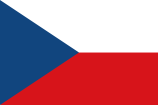 České Budějovice, Czech Republic, since 1987
České Budějovice, Czech Republic, since 1987 Chengdu, China, since 1983
Chengdu, China, since 1983 Gabès, Tunisia, since 1977
Gabès, Tunisia, since 1977 Halle, Germany, since 1975
Halle, Germany, since 1975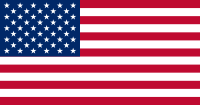 Kansas City, United States, since 1988
Kansas City, United States, since 1988 Gwangyang, South Korea, since 1991
Gwangyang, South Korea, since 1991 Linköping, Sweden, since 1995
Linköping, Sweden, since 1995 Linz am Rhein, Germany, since 1987
Linz am Rhein, Germany, since 1987 Modena, Italy, since 1992
Modena, Italy, since 1992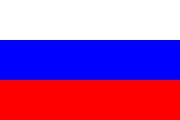 Nizhny Novgorod, Russia, since 1993
Nizhny Novgorod, Russia, since 1993 Norrköping, Sweden, since 1995
Norrköping, Sweden, since 1995 San Carlos, Nicaragua, since 1988
San Carlos, Nicaragua, since 1988 Zaporizhia, Ukraine, since 1983
Zaporizhia, Ukraine, since 1983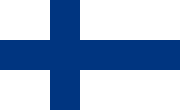 Tampere, Finland, since 1995
Tampere, Finland, since 1995
Notes
- ↑ Paul Hofmann (1987-04-05). "Letting Linz Castle cast a spell". The New York Times. Retrieved on 2008-12-02.
- ↑ "Linz City Travel Guide". About Austria. Retrieved on 2008-04-15.
- ↑ Lundy, Darryl. "A genealogical survey of the peerage of Britain as well as the royal families of Europe". The Peerage. Retrieved on 2008-04-15.
- ↑ City of Linz Website statistik.at - Retrieved 31 October 2007
- ↑ Population linz.at/zahlen - Retrieved 31 October 2007
- ↑ The Plague Column liwest.at - Retrieved 31 October 2007
- ↑ The top of the column linz.at - Retrieved 31 October 2007
- ↑ "St. Martin's Church, Linz (in English)". Linz City Tourist Board. Retrieved on 2008-04-06.
- ↑ "Mariendom (New Cathedral in Linz)". Mariendom. Retrieved on 2008-04-06.
- ↑ Brucknerhaus andreas-praefcke.de - Retrieved 31 October 2007
- ↑ "LASK". LASK. Retrieved on 2008-04-06.
- ↑ George Tabori. "Mein Kampf: Farce in fünf Akten" (in German). Landestheater. Retrieved on 2008-04-06.
- ↑ "Die Spielzeit 2007/2008". Landestheater. Retrieved on 2008-04-06.
- ↑ The Lentos homepage lentos.at - Retrieved 10 November 2007
- ↑ "Welcome Posthof 04 2008". Posthof. Retrieved on 2008-04-06.
- ↑ "Stadtwerkstadt". Stadtwerkstadt. Retrieved on 2008-04-06.
- ↑ "European Capital of Culture". Linz Tourist Board. Retrieved on 2008-04-06.
- ↑ "Fred Astaire (1899-1987) aka Frederick Austerlitz". Hyde Flippo. Retrieved on 2008-08-24.
- ↑ "Andrew Edge". Andrew Edge. Retrieved on 2008-04-06.
- ↑ "Doug Hammond biog". Doug Hammond. Retrieved on 2008-04-06.
- ↑ Sulzer, Balduin. "Das musikalische Nashorn" (in German). Gerhard Brössner. Retrieved on 2008-04-06.
Further reading
- Satchell, Tim. Astaire, The Biography. Hutchinson, London. 1987. ISBN 0-09-173736-2
See also
- List of mayors of Linz
External links
- Linz travel guide from Wikitravel
- LinzGenesis and Museum of the History of Dentistry in Upper Austria [1]
- StifterHaus [2]
- Landesgalerie (Provincial gallery) [3]
- Nordico - Museum of the City of Linz [4]
- The O.K Center for Contemporary Art [5]
- Linz web site (German)
- Linz Picture tour through Linz
- Data about the city (German)
- 360° Panoramic Photos from Linz
- University of Arts and Industrial Design Linz
- Anton Bruckner Private University for Music, Drama, and Dance (German)
- Catholic-Theological Private University Linz (German)
- Official homepage of Linz — The Capital of Culture 2009
- Independent Platform of Linz — European Capital of Culture 2009
- Comprehensive independent travel guide to Linz written by a local
- LISA — Linz International School Auhof
- Ars Electronica Centre
- Lentos Art Museum
- Brucknerhaus concert hall
|
|||||
|
|||||||||||||||||
|
|||||||||

